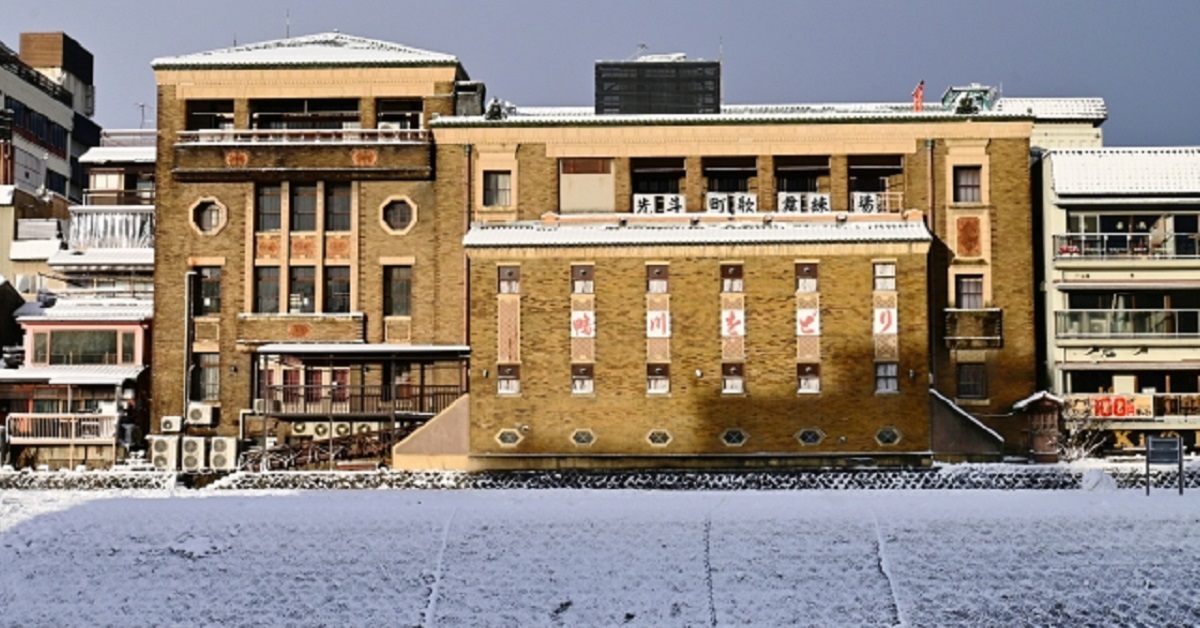The Pontocho Kaburenjo, featured in the film KOKUHO, is a symbolic theater of Kyoto’s traditional culture. Depicted as Naniwaza, its majestic exterior and splendid lobby reinforced the film’s immersive world.
What is Pontocho Kaburenjo?
The Pontocho Kaburenjo, built during the Taisho era, is a historic theater and a stage where Geiko and Maiko present the results of their daily training. It is one of the most prestigious venues among Kyoto’s five kagai (traditional entertainment districts).
The annual spring performance Kamogawa Odori is especially renowned, drawing visitors from across Japan. With its graceful dances, lavish costumes, and elaborate stage designs, it is not just a performance but a comprehensive art form that embodies Kyoto’s seasons and history.
The building itself blends Japanese and Western architectural styles. Its grand exterior harmonizes with the traditional townscape of Pontocho, while the richly decorated interior transports audiences into another world.
Appearing as Naniwaza in the Film
In KOKUHO, the Pontocho Kaburenjo is portrayed as the theater “Naniwaza.” The solemn exterior evokes the atmosphere of a Showa-era playhouse, drawing the audience into the film’s historical setting.
Particularly in the lobby scenes, the grandeur of the space conveys the tension of actors awaiting the stage and the anticipation of the audience. The theater itself functions as a character in the story.
| Item | Naniwaza (in the film) | Pontocho Kaburenjo (reality) |
|---|---|---|
| Exterior | Reproduction of a Showa-era playhouse | Magnificent blend of Japanese and Western architecture |
| Lobby | Expresses the tension before curtain rise | Showcases the elegance of Geiko and Maiko |
| Role | Symbol of the protagonist’s artistic world | A traditional hub sustaining Kyoto’s culture |
Architectural Features
One of the greatest appeals of the Kaburenjo lies in its unique architectural style. Built in the Taisho period, it combines modern Western design with traditional Japanese sensibilities.
- The exterior is constructed with Western influences.
- The interior preserves Japanese aesthetics in detail.
- The stage equipment merges modern technology with traditional techniques.
This fusion of modern architecture and traditional performing arts has also made the Kaburenjo highly valued as a film location.
| Category | Features | Appeal |
|---|---|---|
| Exterior | Western-style architecture | Creates a sense of historical modernity |
| Interior decoration | Japanese motifs with Western lighting | Expresses the refined elegance of Kyoto |
| Stage equipment | State-of-the-art for its era | Highly suitable for film productions |
Historical and Cultural Importance
The Kaburenjo is not merely a theater but a center for preserving and transmitting Kyoto’s culture. For over a century, it has sustained the traditions of the kagai and has become a cultural landmark of Japan.
It also plays a role in international cultural exchange, serving as an entry point for visitors from abroad to experience Kyoto’s performing arts.
The Cinematic Role in KOKUHO
In film, the choice of setting profoundly shapes the story. As “Naniwaza,” the Pontocho Kaburenjo became a symbolic presence reflecting the protagonist’s growth and artistic struggles.
- The exterior conveys the dignity of a playhouse.
- The lobby reflects the emotions of both actors and audience.
- The stage represents the pinnacle of artistic expression.
The film’s success owes much to the powerful presence of this real-world theater.
| Scene | Theater’s role | Effect |
|---|---|---|
| Exterior depiction | Symbol of the playhouse | Realistically recreates the historical backdrop |
| Lobby depiction | Conveys the anticipation of the audience | Creates tension and excitement |
| Stage depiction | Site of the protagonist’s artistic struggles | Adds depth to the narrative |
The Kaburenjo as a Tourism Resource
After the release of KOKUHO, more visitors began to seek out the Pontocho Kaburenjo. For fans of the film, it became a site of pilgrimage, while also serving as an introduction to Kyoto’s traditional culture.
The Kamogawa Odori and other special performances provide audiences with an unforgettable experience, blending tourism with cultural appreciation.
| Tourism Resource | Content | Value |
|---|---|---|
| Pilgrimage site | Visiting the film’s location | Enhances fan satisfaction |
| Traditional performances | Kamogawa Odori | Immersive experience of Kyoto’s culture |
| Surrounding attractions | Tea houses, townhouses, Kyoto cuisine | Offers authentic Kyoto atmosphere |
Connection with Surrounding Culture
The charm of Pontocho extends beyond the Kaburenjo itself. The narrow stone-paved alleys, wooden lattice townhouses, and the sound of shamisen at night create an ambiance that is inherently cinematic.
After experiencing a performance at the Kaburenjo, visitors can savor Kyoto cuisine at nearby tea houses or stroll along the Kamo River, engaging in a Kyoto experience where art and daily life seamlessly intertwine.
Conclusion
The Pontocho Kaburenjo, as the theater “Naniwaza” in KOKUHO, became a stage etched deeply into the audience’s memory. Its historical background and cultural value make it an indispensable attraction in Kyoto, serving as a bridge between film and reality.
As a theater that continues to uphold Kyoto’s traditions, the Kaburenjo is both a symbol of continuity between past and future and a center for art and tourism that will continue to shine for generations to come.






